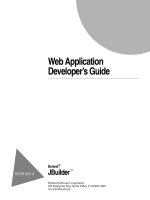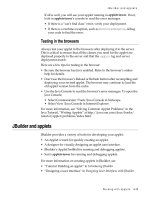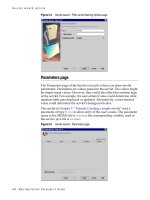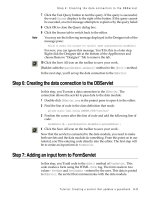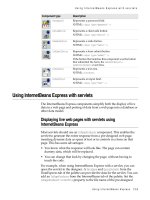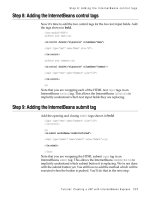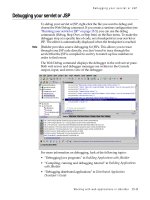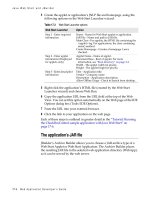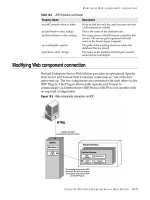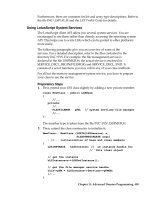ARM System Developer’s Guide phần 7 pdf
Bạn đang xem bản rút gọn của tài liệu. Xem và tải ngay bản đầy đủ của tài liệu tại đây (457.36 KB, 70 trang )
408 Chapter 12 Caches
The cache makes use of this repeated local reference in both time and space. If the
reference is in time, it is called temporal locality. If it is by address proximity, then it is called
spatial locality.
12.2 Cache Architecture
ARM uses two bus architectures in its cached cores, the Von Neumann and the Harvard.
The Von Neumann and Harvard bus architectures differ in the separation of the instruction
and data paths between the core and memory. A different cache design is used to support
the two architectures.
In processor cores using the Von Neumann architecture, there is a single cache used
for instruction and data. This type of cache is known as a unified cache. A unified cache
memory contains both instruction and data values.
The Harvard architecture has separate instruction and data buses to improve overall
system performance, but supporting the two buses requires two caches. In processor cores
using the Harvard architecture, there are two caches: an instruction cache (I-cache) and
a data cache (D-cache). This type of cache is known as a split cache. In a split cache,
instructions are stored in the instruction cache and data values are stored in the data cache.
We introduce the basic architecture of caches by showing a unified cache in Figure 12.4.
The two main elements of a cache are the cache controller and the cache memory. The
cache memory is a dedicated memory array accessed in units called cache lines. The cache
controller uses different portions of the address issued by the processor during a memory
request to select parts of cache memory. We will present the architecture of the cache
memory first and then proceed to the details of the cache controller.
12.2.1 Basic Architecture of a Cache Memory
A simple cache memory is shown on the right side of Figure 12.4. It has three main parts:
a directory store, a data section, and status information. All three parts of the cache memory
are present for each cache line.
The cache must know where the information stored in a cache line originates from in
main memory. It uses a directory store to hold the address identifying where the cache line
was copied from main memory. The directory entry is known as a cache-tag.
A cache memory must also store the data read from main memory. This information is
held in the data section (see Figure 12.4).
The size of a cache is defined as the actual code or data the cache can store from main
memory. Not included in the cache size is the cache memory required to support cache-tags
or status bits.
There are also status bits in cache memory to maintain state information. Two common
status bits are the valid bit and dirty bit. A valid bit marks a cache line as active, meaning
it contains live data originally taken from main memory and is currently available to the
12.2 Cache Architecture 409
Address issued
by processor core
Cache
controller
Cache
memory
Directory
store
Hit
Miss
Cache
line
Address/data
bus
Compare
Tag
Set
index
Data
index
31
12
11
4
3
0
Cache-tag v d word3 word2 word1 word0
Cache-tag v d word3 word2 word1 word0
Cache-tag v d word3 word2 word1 word0
Cache-tag v d word3 word2 word1 word0
Cache-tag v d word3 word2 word1 word0
Cache-tag v d word3 word2 word1 word0
Cache-tag v d word3 word2 word1 word0
Cache-tag v d word3 word2 word1 word0
Status Data
.
.
.
Figure 12.4 A 4 KB cache consisting of 256 cache lines of four 32-bit words.
processor core on demand. A dirty bit defines whether or not a cache line contains data
that is different from the value it represents in main memory. We explain dirty bits in more
detail in Section 12.3.1.
12.2.2 Basic Operation of a Cache Controller
The cache controller is hardware that copies code or data from main memory to cache
memory automatically. It performs this task automatically to conceal cache operation from
the software it supports. Thus, the same application software can run unaltered on systems
with and without a cache.
The cache controller intercepts read and write memory requests before passing them on
to the memory controller. It processes a request by dividing the address of the request into
three fields, the tag field, the set index field, and the data index field. The three bit fields are
shown in Figure 12.4.
First, the controller uses the set index portion of the address to locate the cache line
within the cache memory that might hold the requested code or data. This cache line
contains the cache-tag and status bits, which the controller uses to determine the actual
data stored there.
410 Chapter 12 Caches
The controller then checks the valid bit to determine if the cache line is active, and
compares the cache-tag to the tag field of the requested address. If both the status check
and comparison succeed, it is a cache hit. If either the status check or comparison fails, it is
a cache miss.
On a cache miss, the controller copies an entire cache line from main memory to cache
memory and provides the requested code or data to the processor. The copying of a cache
line from main memory to cache memory is known as a cache line fill.
On a cache hit, the controller supplies the code or data directly from cache memory to
the processor. To do this it moves to the next step, which is to use the data index field of
the address request to select the actual code or data in the cache line and provide it to the
processor.
12.2.3 The Relationship between Cache and Main Memory
Having a general understanding of basic cache memory architecture and how the cache
controller works provides enough information to discuss the relationship that a cache has
with main memory.
Figure 12.5 shows where portions of main memory are temporarily stored in cache
memory. The figure represents the simplest form of cache, known as a direct-mapped cache.
In a direct-mapped cache each addressed location in main memory maps to a single location
in cache memory. Since main memory is much larger than cache memory, there are many
addresses in main memory that map to the same single location in cache memory. The
figure shows this relationship for the class of addresses ending in 0x824.
The three bit fields introduced in Figure 12.4 are also shown in this figure. The set index
selects the one location in cache where all values in memory with an ending address of
0x824 are stored. The data index selects the word/halfword/byte in the cache line, in this
case the second word in the cache line. The tag field is the portion of the address that is
compared to the cache-tag value found in the directory store. In this example there are one
million possible locations in main memory for every one location in cache memory. Only
one of the possible one million values in the main memory can exist in the cache memory
at any given time. The comparison of the tag with the cache-tag determines whether the
requested data is in cache or represents another of the million locations in main memory
with an ending address of 0x824.
During a cache line fill the cache controller may forward the loading data to the core at
the same time it is copying it to cache; this is known as data streaming. Streaming allows a
processor to continue execution while the cache controller fills the remaining words in the
cache line.
If valid data exists in this cache line but represents another address block in main
memory, the entire cache line is evicted and replaced by the cache line containing the
requested address. This process of removing an existing cache line as part of servicing a
cache miss is known as eviction—returning the contents of a cache line to main memory
from the cache to make room for new data that needs to be loaded in cache.
12.2 Cache Architecture 411
Main memory
4 KB cache memory
(direct mapped)
XXXXX 8 2 4
tag
31 12
0xFFF
0x820
0x000
Address issued by processor core
11 4 3 0
set index data index
0xFFFFFFFF
0xFFFFF000
0xFFFFE000
0x00003000
0x00002000
0x00001000
0x00000000
4 KB
0x00000824
0x00001824
0x00002824
.
.
.
0xFFFFE824
0xFFFFF824
Cache-tag v d word3 word2 word1 word0
Figure 12.5 How main memory maps to a direct-mapped cache.
A direct-mapped cache is a simple solution, but there is a design cost inherent in having
a single location available to store a value from main memory. Direct-mapped caches are
subject to high levels of thrashing—a software battle for the same location in cache memory.
The result of thrashing is the repeated loading and eviction of a cache line. The loading and
eviction result from program elements being placed in main memory at addresses that map
to the same cache line in cache memory.
Figure 12.6 takes Figure 12.5 and overlays a simple, contrived software procedure to
demonstrate thrashing. The procedure calls two routines repeatedly in a do while loop.
Each routine has the same set index address; that is, the routines are found at addresses in
physical memory that map to the same location in cache memory. The first time through
the loop, routine A is placed in the cache as it executes. When the procedure calls routine B,
it evicts routine A a cache line at a time as it is loaded into cache and executed. On the second
time through the loop, routine A replaces routine B, and then routine B replaces routine A.
412 Chapter 12 Caches
Main memory
Software procedure
Cache memory
Data array
Routine B
Routine A
4 KB,
direct-mapped
unified cache
0xFFF
0x480
0x000
0x00002000
0x00001000
0x00000000
0x00000480
do
{
routineA();
routineB();
x ;
} while (x>0)
0x00001480
0x00002480
.
.
.
Figure 12.6 Thrashing: two functions replacing each other in a direct-mapped cache.
Repeated cache misses result in continuous eviction of the routine that not running. This
is cache thrashing.
12.2.4 Set Associativity
Some caches include an additional design feature to reduce the frequency of thrashing (see
Figure 12.7). This structural design feature is a change that divides the cache memory into
smaller equal units, called ways. Figure 12.7 is still a four KB cache; however, the set index
now addresses more than one cache line—it points to one cache line in each way. Instead
of one way of 256 lines, the cache has four ways of 64 lines. The four cache lines with the
same set index are said to be in the same set, which is the origin of the name “set index.”
12.2 Cache Architecture 413
Address issued
by processor core
Cache
controller
Cache
memory
Hit
Miss
Way 3
Way 2
Way 1
Way 0
Compare
Tag
Set
index
Data
index
31
10
9
4
3
0
Cache-tag v d word3 word2 word1 word0
Cache-tag v d word3 word2 word1 word0
Cache-tag v d word3 word2 word1 word0
Cache-tag v d word3 word2 word1 word0
Cache-tag v d word3 word2 word1 word0
Cache-tag
v d word3 word2 word1 word0
Cache-tag v d word3 word2 word1 word0
Cache-tag v d word3 word2 word1 word0
.
.
.
Cache-tag v d word3 word2 word1 word0
Cache-tag v d word3 word2 word1 word0
Cache-tag v d word3 word2 word1 word0
Cache-tag v d word3 word2 word1 word0
Cache-tag v d word3 word2 word1 word0
Cache-tag
v d word3 word2 word1 word0
Cache-tag v d word3 word2 word1 word0
Cache-tag v d word3 word2 word1 word0
.
.
.
Cache-tag v d word3 word2 word1 word0
Cache-tag v d word3 word2 word1 word0
Cache-tag v d word3 word2 word1 word0
Cache-tag v d word3 word2 word1 word0
Cache-tag v d word3 word2 word1 word0
Cache-tag
v d word3 word2 word1 word0
Cache-tag v d word3 word2 word1 word0
Cache-tag v d word3 word2 word1 word0
.
.
.
Directory
store
64 cache
lines per
way
Address/data
bus
Cache-tag v d word3 word2 word1 word0
Cache-tag v d word3 word2 word1 word0
Cache-tag v d word3 word2 word1 word0
Cache-tag v d word3 word2 word1 word0
Cache-tag v d word3 word2 word1 word0
Cache-tag v d word3 word2 word1 word0
Cache-tag v d word3 word2 word1 word0
Status Data
Cache-tag v d word3 word2 word1 word0
.
.
.
Figure 12.7 A 4 KB, four-way set associative cache. The cache has 256 total cache lines, which are
separated into four ways, each containing 64 cache lines. The cache line contains four
words.
414 Chapter 12 Caches
The set of cache lines pointed to by the set index are set associative. A data or code
block from main memory can be allocated to any of the four ways in a set without affecting
program behavior; in other words the storing of data in cache lines within a set does not
affect program execution. Two sequential blocks from main memory can be stored as cache
lines in the same way or two different ways. The important thing to note is that the data or
code blocks from a specific location in main memory can be stored in any cache line that
is a member of a set. The placement of values within a set is exclusive to prevent the same
code or data block from simultaneously occupying two cache lines in a set.
The mapping of main memory to a cache changes in a four-way set associative cache.
Figure 12.8 shows the differences. Any single location in main memory now maps to four
different locations in the cache. Although Figures 12.5 and 12.8 both illustrate 4 KB caches,
here are some differences worth noting.
The bit field for the tag is now two bits larger, and the set index bit field is two bits
smaller. This means four million main memory addresses now map to one set of four cache
lines, instead of one million addresses mapping to one location.
The size of the area of main memory that maps to cache is now 1 KB instead of 4 KB.
This means that the likelihood of mapping cache line data blocks to the same set is now four
times higher. This is offset by the fact that a cache line is one fourth less likely to be evicted.
If the example code shown in Figure 12.6 were run in the four-way set associative cache
shown in Figure 12.8, the incidence of thrashing would quickly settle down as routine A,
routine B, and the data array would establish unique places in the four available locations
in a set. This assumes that the size of each routine and the data are less than the new smaller
1 KB area that maps from main memory.
12.2.4.1 Increasing Set Associativity
As the associativity of a cache controller goes up, the probability of thrashing goes down.
The ideal goal would be to maximize the set associativity of a cache by designing it so
any main memory location maps to any cache line. A cache that does this is known as a
fully associative cache. However, as the associativity increases, so does the complexity of
the hardware that supports it. One method used by hardware designers to increase the set
associativity of a cache includes a content addressable memory (CAM).
A CAM uses a set of comparators to compare the input tag address with a cache-tag
stored in each valid cache line. A CAM works in the opposite way a RAM works. Where a
RAM produces data when given an address value, a CAM produces an address if a given data
value exists in the memory. Using a CAM allows many more cache-tags to be compared
simultaneously, thereby increasing the number of cache lines that can be included in a set.
Using a CAM to locate cache-tags is the design choice ARM made in their ARM920T
and ARM940T processor cores. The caches in the ARM920T and ARM940T are 64-way set
associative. Figure 12.9 shows a block diagram of an ARM940T cache. The cache controller
uses the address tag as the input to the CAM and the output selects the way containing the
valid cache line.
12.2 Cache Architecture 415
4G main memory
1 KB
Way 0
XXXXX 2 2 4
tag
31 10
0x3FF
0x224
0x000
Address issued by processor core
943 0
set index data index
0xFFFFFFFF
0x00000C00
0x00000800
0x00000400
0x00000000
0x00000224
0x00000424
0x00000824
.
.
.
cache-tag v d word3 word2 word1 word0
Way 1
0x3FF
0x224
0x000
cache-tag v d word3 word2 word1 word0
Way 2
0x3FF
0x224
0x000
cache-tag v d word3 word2 word1 word0
Way 3
0x3FF
0x224
0x000
cache-tag v d word3 word2 word1 word0
Figure 12.8 Main memory mapping to a four-way set associative cache.
416 Chapter 12 Caches
Address issued
by processor core
Cache
controller
Cache
memory
Miss
Tag
Set
index
Data
index
31
8
7
4
3
0
CAM
set
select
logic
64 ways
Address/data
bus
Compare logic
4 cache
lines per
way
Cache-tag v d DataCam3
Cache-tag v d DataCam2
Cache-tag v d DataCam1
Cache-tagCam0 v d Data
Figure 12.9 ARM940T—4 KB 64-way set associative D-cache using a CAM.
The tag portion of the requested address is used as an input to the four CAMs that
simultaneously compare the input tag with all cache-tags stored in the 64 ways. If there is
a match, cache data is provided by the cache memory. If no match occurs, a miss signal is
generated by the memory controller.
The controller enables one of four CAMs using the set index bits. The indexed CAM
then selects a cache line in cache memory and the data index portion of the core address
selects the requested word, halfword, or byte within the cache line.
12.2.5 Write Buffers
A write buffer is a very small, fast FIFO memory buffer that temporarily holds data that the
processor would normally write to main memory. In a system without a write buffer, the
processor writes directly to main memory. In a system with a write buffer, data is written at
high speed to the FIFO and then emptied to slower main memory. The write buffer reduces
the processor time taken to write small blocks of sequential data to main memory. The
FIFO memory of the write buffer is at the same level in the memory hierarchy as the L1
cache and is shown in Figure 12.1.
12.2 Cache Architecture 417
The efficiency of the write buffer depends on the ratio of main memory writes to the
number of instructions executed. Over a given time interval, if the number of writes to
main memory is low or sufficiently spaced between other processing instructions, the write
buffer will rarely fill. If the write buffer does not fill, the running program continues
to execute out of cache memory using registers for processing, cache memory for reads
and writes, and the write buffer for holding evicted cache lines while they drain to main
memory.
A write buffer also improves cache performance; the improvement occurs during cache
line evictions. If the cache controller evicts a dirty cache line, it writes the cache line to the
write buffer instead of main memory. Thus the new cache line data will be available sooner,
and the processor can continue operating from cache memory.
Data written to the write buffer is not available for reading until it has exited the write
buffer to main memory. The same holds true for an evicted cache line: it too cannot be
read while it is in the write buffer. This is one of the reasons that the FIFO depth of a write
buffer is usually quite small, only a few cache lines deep.
Some write buffers are not strictly FIFO buffers. The ARM10 family, for example,
supports coalescing—the merging of write operations into a single cache line. The write
buffer will merge the new value into an existing cache line in the write buffer if they
represent the same data block in main memory. Coalescing is also known as write merging,
write collapsing,orwrite combining.
12.2.6 Measuring Cache Efficiency
There are two terms used to characterize the cache efficiency of a program: the cache
hit rate and the cache miss rate. The hit rate is the number of cache hits divided by the
total number of memory requests over a given time interval. The value is expressed as
a percentage:
hit rate =
cache hits
memory requests
× 100
The miss rate is similar in form: the total cache misses divided by the total number of
memory requests expressed as a percentage over a time interval. Note that the miss rate also
equals 100 minus the hit rate.
The hit rate and miss rate can measure reads, writes, or both, which means that the
terms can be used to describe performance information in several ways. For example,
there is a hit rate for reads, a hit rate for writes, and other measures of hit and miss
rates.
Two other terms used in cache performance measurement are the hit time—the time it
takes to access a memory location in the cache and the miss penalty—the time it takes to
load a cache line from main memory into cache.
418 Chapter 12 Caches
12.3 Cache Policy
There are three policies that determine the operation of a cache: the write policy, the
replacement policy, and the allocation policy. The cache write policy determines where
data is stored during processor write operations. The replacement policy selects the cache
line in a set that is used for the next line fill during a cache miss. The allocation policy
determines when the cache controller allocates a cache line.
12.3.1 Write Policy—Writeback or Writethrough
When the processor core writes to memory, the cache controller has two alternatives for
its write policy. The controller can write to both the cache and main memory, updating
the values in both locations; this approach is known as writethrough. Alternatively, the
cache controller can write to cache memory and not update main memory, this is known
as writeback or copyback.
12.3.1.1 Writethrough
When the cache controller uses a writethrough policy, it writes to both cache and main
memory when there is a cache hit on write, ensuring that the cache and main memory
stay coherent at all times. Under this policy, the cache controller performs a write to
main memory for each write to cache memory. Because of the write to main memory,
a writethrough policy is slower than a writeback policy.
12.3.1.2 Writeback
When a cache controller uses a writeback policy, it writes to valid cache data memory
and not to main memory. Consequently, valid cache lines and main memory may contain
different data. The cache line holds the most recent data, and main memory contains older
data, which has not been updated.
Caches configured as writeback caches must use one or more of the dirty bits in the
cache line status information block. When a cache controller in writeback writes a value to
cache memory, it sets the dirty bit true. If the core accesses the cache line at a later time, it
knows by the state of the dirty bit that the cache line contains data not in main memory. If
the cache controller evicts a dirty cache line, it is automatically written out to main memory.
The controller does this to prevent the loss of vital information held in cache memory and
not in main memory.
One performance advantage a writeback cache has over a writethrough cache is in the
frequent use of temporary local variables by a subroutine. These variables are transient in
nature and never really need to be written to main memory. An example of one of these
12.3 Cache Policy 419
transient variables is a local variable that overflows onto a cached stack because there are
not enough registers in the register file to hold the variable.
12.3.2 Cache Line Replacement Policies
On a cache miss, the cache controller must select a cache line from the available set in
cache memory to store the new information from main memory. The cache line selected
for replacement is known as a victim. If the victim contains valid, dirty data, the controller
must write the dirty data from the cache memory to main memory before it copies new
data into the victim cache line. The process of selecting and replacing a victim cache line is
known as eviction.
The strategy implemented in a cache controller to select the next victim is called its
replacement policy. The replacement policy selects a cache line from the available associative
member set; that is, it selects the way touse in the next cache line replacement. Tosummarize
the overall process, the set index selects the set of cache lines available in the ways, and the
replacement policy selects the specific cache line from the set to replace.
ARM cached cores support two replacement policies, either pseudorandom or
round-robin.
■
Round-robin or cyclic replacement simply selects the next cache line in a set to replace.
The selection algorithm uses a sequential, incrementing victim counter that increments
each time the cache controller allocates a cache line. When the victim counter reaches
a maximum value, it is reset to a defined base value.
■
Pseudorandom replacement randomly selects the next cache line in a set to replace. The
selection algorithm uses a nonsequential incrementing victim counter. In a pseudoran-
dom replacement algorithm the controller increments the victim counter by randomly
selecting an increment value and adding this value to the victim counter. When the
victim counter reaches a maximum value, it is reset to a defined base value.
Most ARM cores support both policies (see Table 12.1 for a comprehensive list of ARM
cores and the policies they support). The round-robin replacement policy has greater pre-
dictability, which is desirable in an embedded system. However, a round-robin replacement
policy is subject to large changes in performance given small changes in memory access. To
show this change in performance, we provide Example 12.1.
Example
12.1
This example determines the time it takes to execute a software routine using the round-
robin and random replacement policies. The test routine cache_RRtest collects timings
using the clock function available in the C library header time.h. First, it enables a round
robin policy and runs a timing test, and then enables the random policy and runs the
same test.
The test routine readSet is written specifically for an ARM940T and intentionally shows
a worst-case abrupt change in cache behavior using a round-robin replacement policy.
420 Chapter 12 Caches
Table 12.1 ARM cached core policies.
Core Write policy Replacement policy Allocation policy
ARM720T writethrough random read-miss
ARM740T writethrough random read-miss
ARM920T writethrough, writeback random, round-robin read-miss
ARM940T writethrough, writeback random read-miss
ARM926EJS writethrough, writeback random, round-robin read-miss
ARM946E writethrough, writeback random, round-robin read-miss
ARM10202E writethrough, writeback random, round-robin read-miss
ARM1026EJS writethrough, writeback random, round-robin read-miss
Intel StrongARM writeback round-robin read-miss
Intel XScale writethrough, writeback round-robin read-miss, write-miss
#include <stdio.h>
#include <time.h>
void cache_RRtest(int times,int numset)
{
clock_t count;
printf("Round Robin test size = %d\r\n", numset);
enableRoundRobin();
cleanFlushCache();
count = clock();
readSet(times,numset);
count = clock() - count;
printf("Round Robin enabled = %.2f seconds\r\n",
(float)count/CLOCKS_PER_SEC);
enableRandom();
cleanFlushCache();
count = clock();
readSet(times, numset);
count = clock() - count;
printf("Random enabled = %.2f seconds\r\n\r\n",
(float)count/CLOCKS_PER_SEC);
}
int readSet( int times, int numset)
{
12.3 Cache Policy 421
int setcount, value;
volatile int *newstart;
volatile int *start = (int *)0x20000;
__asm
{
timesloop:
MOV newstart, start
MOV setcount, numset
setloop:
LDR value,[newstart,#0];
ADD newstart,newstart,#0x40;
SUBS setcount, setcount, #1;
BNE setloop;
SUBS times, times, #1;
BNE timesloop;
}
return value;
}
We wrote the readSet routine to fill a single set in the cache. There are two arguments
to the function. The first, times, is the number of times to run the test loop; this value
increases the time it takes to run the test. The second, numset, is the number of set values
to read; this value determines the number of cache lines the routine loads into the same
set. Filling the set with values is done in a loop using an LDR instruction that reads a value
from a memory location and then increments the address by 16 words (64 bytes) in each
pass through the loop. Setting the value of numset to 64 will fill all the available cache lines
in a set in an ARM940T. There are 16 words in a way and 64 cache lines per set in the
ARM940T.
Here are two calls to the round-robin test using two set sizes. The first reads and fills a
set with 64 entries; the second attempts to fill the set with 65 entries.
unsigned int times = 0x10000;
unsigned int numset = 64;
cache_RRtest(times, numset);
numset = 65;
cache_RRtest(times, numset);
The console output of the two tests follows. The tests were run on an ARM940T core
module simulated using the ARM ADS1.2 ARMulator with a core clock speed of 50 MHz
and a memory read access time of 100 ns nonsequential and 50 ns sequential. The thing to
notice is the change in timing for the round-robin test reading 65 set values.
422 Chapter 12 Caches
Round Robin test size = 64
Round Robin enabled = 0.51 seconds
Random enabled = 0.51 seconds
Round Robin test size = 65
Round Robin enabled = 2.56 seconds
Random enabled = 0.58 seconds
This is an extreme example, but it does shows a difference between using a round-robin
policy and a random replacement policy. ■
Another common replacement policy is least recently used (LRU). This policy keeps
track of cache line use and selects the cache line that has been unused for the longest time
as the next victim.
ARM’s cached cores do not support a least recently used replacement policy, although
ARM’s semiconductor partners have taken noncached ARM cores and added their own
cache to the chips they produce. So there are ARM-based products that use an LRU
replacement policy.
12.3.3 Allocation Policy on a Cache Miss
There are two strategies ARM caches may use to allocate a cache line after a the occurrence
of a cache miss. The first strategy is known as read-allocate, and the second strategy is known
as read-write-allocate.
A read allocate on cache miss policy allocates a cache line only during a read from main
memory. If the victim cache line contains valid data, then it is written to main memory
before the cache line is filled with new data.
Under this strategy, a write of new data to memory does not update the contents of the
cache memory unless a cache line was allocated on a previous read from main memory.
If the cache line contains valid data, then a write updates the cache and may update main
memory if the cache write policy is writethrough. If the data is not in cache, the controller
writes to main memory only.
A read-write allocate on cache miss policy allocates a cache line for either a read or write
to memory. Any load or store operation made to main memory, which is not in cache
memory, allocates a cache line. On memory reads the controller uses a read-allocate policy.
On a write, the controller also allocates a cache line. If the victim cache line contains
valid data, then it is first written back to main memory before the cache controller fills the
victim cache line with new data from main memory. If the cache line is not valid, it simply
does a cache line fill. After the cache line is filled from main memory, the controller writes
the data to the corresponding data location within the cache line. The cached core also
updates main memory if it is a writethrough cache.
The ARM7, ARM9, and ARM10 cores use a read-allocate on miss policy; the Intel XScale
supports both read-allocate and write-allocate on miss. Table 12.1 provides a listing of the
policies supported by each core.
12.5 Flushing and Cleaning Cache Memory 423
12.4 Coprocessor 15 and Caches
There are several coprocessor 15 registers used to specifically configure and control ARM
cached cores. Table 12.2 lists the coprocessor 15 registers that control cache configuration.
Primary CP15 registers c7 and c9 control the setup and operation of cache. Secondary
CP15:c7 registers are write only and clean and flush cache. The CP15:c9 register defines
the victim pointer base address, which determines the number of lines of code or data
that are locked in cache. We discuss these commands in more detail in the sections
that follow. To review the general use of coprocessor 15 instructions and syntax, see
Section 3.5.2.
There are other CP15 registers that affect cache operation; the definition of these registers
is core dependent. These other registers are explained in Chapter 13 in Sections 13.2.3 and
13.2.4 on initializing the MPU, and in Chapter 14 in Section 14.3.6 on initializing the MMU.
In the next several sections we use the CP15 registers listed in Table 12.2 to provide
example routines to clean and flush caches, and to lock code or data in cache. The control
system usually calls these routines as part of its memory management activities.
12.5 Flushing and Cleaning Cache Memory
ARM uses the terms flush and clean to describe two basic operations performed on a
cache.
To “flush a cache” is to clear it of any stored data. Flushing simply clears the valid bit in
the affected cache line. All or just portions of a cache may need flushing to support changes
in memory configuration. The term invalidate is sometimes used in place of the term flush.
However, if some portion of the D-cache is configured to use a writeback policy, the data
cache may also need cleaning.
To “clean a cache” is to force a write of dirty cache lines from the cache out to main
memory and clear the dirty bits in the cache line. Cleaning a cache reestablishes coherence
between cached memory and main memory, and only applies to D-caches using a writeback
policy.
Table 12.2 Coprocessor 15 registers that configure and control cache operation.
Function Primary register Secondary registers Opcode 2
Clean and flush cache c7 c5, c6, c7, c10, c13, c14 0, 1, 2
Drain write buffer c7 c10 4
Cache lockdown c9 c0 0, 1
Round-robin replacement c15 c0 0
424 Chapter 12 Caches
Changing the memory configuration of a system may require cleaning or flushing a
cache. The need to clean or flush a cache results directly from actions like changing the
access permission, cache, and buffer policy, or remapping virtual addresses.
The cache may also need cleaning or flushing before the execution of self-modifying
code in a split cache. Self-modifying code includes a simple copy of code from one location
to another. The need to clean or flush arises from two possible conditions: First, the self-
modifying code may be held in the D-cache and therefore be unavailable to load from
main memory as an instruction. Second, existing instructions in the I-cache may mask new
instructions written to main memory.
If a cache is using a writeback policy and self-modifying code is written to main memory,
the first step is to write the instructions as a block of data to a location in main memory. At
a later time, the program will branch to this memory and begin executing from that area of
memory as an instruction stream. During the first write of code to main memory as data, it
may be written to cache memory instead; this occurs in an ARM cache if valid cache lines
exist in cache memory representing the location where the self-modifying code is written.
The cache lines are copied to the D-cache and not to main memory. If this is the case, then
when the program branches to the location where the self-modifying code should be, it will
execute old instructions still present because the self-modifying code is still in the D-cache.
To prevent this, clean the cache, which forces the instructions stored as data into main
memory, where they can be read as an instruction stream.
If the D-cache has been cleaned, new instructions are present in main memory. However,
the I-cache may have valid cache lines stored for the addresses where the new data (code)
was written. Consequently, a fetch of the instruction at the address of the copied code would
retrieve the old code from the I-cache and not the new code from main memory. Flush the
I-cache to prevent this from happening.
12.5.1 Flushing ARM Cached Cores
Flushing a cache invalidates the contents of a cache. If the cache is using a writeback policy,
care should be taken to clean the cache before flushing so data is not lost as a result of the
flushing process.
There are three CP15:c7 commands that perform flush operations on a cache. The first
flushes the entire cache, the second flushes just the I-cache, and the third just the D-cache.
The commands and cores that support them are shown in Table 12.3. The value of the
processor core register Rd should be zero for all three MCR instructions.
We provide Example 12.2 to show how to flush caches using these instructions. The
example can be used “as is” or customized to suit the requirements of the system. The
example contains a macro that produces three routines (for information on using macros,
see Appendix A):
■
flushICache flushes the I-cache.
■
flushDCache flushes the D-cache.
12.5 Flushing and Cleaning Cache Memory 425
Table 12.3 CP15:c7:Cm commands to flush the entire cache.
Command MCR instruction Core support
Flush cache MCR p15, 0, Rd, c7, c7, 0 ARM720T, ARM920T, ARM922T, ARM926EJ-S,
ARM1022E, ARM1026EJ-S, StrongARM, XScale
Flush data cache MCR p15, 0, Rd, c7, c6, 0 ARM920T, ARM922T, ARM926EJ-S, ARM940T,
ARM946E-S, ARM1022E, ARM1026EJ-S,
StrongARM, XScale
Flush instruction cache MCR p15, 0, Rd, c7, c5, 0 ARM920T, ARM922T, ARM926EJ-S, ARM940T,
ARM946E-S, ARM1022E, ARM1026EJ-S,
StrongARM, XScale
■
flushCache flushes both the I-cache and D-cache.
The routines have no input parameters and are called from C with the following
prototypes:
void flushCache(void); /* flush all cache */
void flushDCache(void); /* flush D-cache */
void flushICache(void); /* flush I-cache */
Example
12.2
This example begins by filtering the cores into groups based on the commands that they
support.
We use a macro called CACHEFLUSH to help in the creation of the routines. The
macro starts by setting the core register written to the CP15:c7:Cm to zero. Then it inserts
the specific MCR instruction depending on the type of cache operation needed and its
availability within each core.
IF {CPU} = "ARM720T" :LOR: \
{CPU} = "ARM920T" :LOR: \
{CPU} = "ARM922T" :LOR: \
{CPU} = "ARM926EJ-S" :LOR: \
{CPU} = "ARM940T" :LOR: \
{CPU} = "ARM946E-S" :LOR: \
{CPU} = "ARM1022E" :LOR: \
{CPU} = "ARM1026EJ-S" :LOR: \
{CPU} = "SA-110" :LOR: \
{CPU} = "XSCALE"
c7f RN 0 ; register in CP17:c7 format
426 Chapter 12 Caches
MACRO
CACHEFLUSH $op
MOV c7f, #0
IF "$op" = "Icache"
MCR p15,0,c7f,c7,c5,0 ; flush I-cache
ENDIF
IF "$op" = "Dcache"
MCR p15,0,c7f,c7,c6,0 ; flush D-cache
ENDIF
IF "$op" = "IDcache"
IF {CPU} = "ARM940T" :LOR: \
{CPU} = "ARM946E-S"
MCR p15,0,c7f,c7,c5,0 ; flush I-cache
MCR p15,0,c7f,c7,c6,0 ; flush D-cache
ELSE
MCR p15,0,c7f,c7,c7,0 ; flush I-cache & D-cache
ENDIF
ENDIF
MOV pc, lr
MEND
IF {CPU} = "ARM720T"
EXPORT flushCache
flushCache
CACHEFLUSH IDcache
ELSE
EXPORT flushCache
EXPORT flushICache
EXPORT flushDCache
flushCache
CACHEFLUSH IDcache
flushICache
CACHEFLUSH Icache
flushDCache
CACHEFLUSH Dcache
ENDIF
Finally, we use the macro several times to create the routines. The ARM720T has a unified
cache so only the flushCache routine is available; otherwise, the routine uses the macro
three times to create the routines. ■
This example contains a little more code than most implementations require. However,
it is provided as an exhaustive routine that supports all current ARM processor cores.
12.5 Flushing and Cleaning Cache Memory 427
You can use Example 12.2 to create simpler routines dedicated to the specific core you are
using. We use an ARM926EJ-S as a model to show how the three routines can be extracted
from Example 12.2. The rewritten version is
EXPORT flushCache926
EXPORT flushICache926
EXPORT flushDCache926
c7f RN 0 ; register in CP15:c7 format
flushCache926
MCR p15,0,c7f,c7,c7,0 ; flush I-cache & D-cache
MOV pc, lr
flushICache926
MCR p15,0,c7f,c7,c5,0 ; flush I-cache
MOV pc, lr
flushDCache926
MCR p15,0,c7f,c7,c6,0 ; flush D-cache
MOV pc, lr
If you are writing in C, you might simplify this code even further and make them inline
functions that can be collected and placed in an include file. The inline functions are
__inline void flushCache926(void)
{
unsigned int c7format = 0;
__asm{ MCR p15,0,c7format,c7,c7,0 }; /* flush I&D-cache */
}
__inline void flushDcache926(void)
{
unsigned int c7format = 0;
__asm{MCR p15,0,c7format,c7,c6,0 } /* flush D-cache */
}
__inline void flushIcache926(void)
{
unsigned int c7format = 0;
__asm{MCR p15,0,c7format,c7,c5,0 } /* flush I-cache */
}
The remainder of the examples in this chapter are presented in ARM assembler and
support all current cores. The same extraction procedures can be applied to the routines
provided.
428 Chapter 12 Caches
12.5.2 Cleaning ARM Cached Cores
To clean a cache is to issue commands that force the cache controller to write all dirty
D-cache lines out to main memory. In the process the dirty status bits in the cache line
are cleared. Cleaning a cache reestablishes coherence between cached memory and main
memory and can only apply to D-caches using a writeback policy.
The terms writeback and copyback are sometimes used in place of the term clean.Soto
force a writeback or copyback of cache to main memory is the same as cleaning the cache.
The terms are similar to the adjectives used to describe cache write policy; however, in this
case they describe an action performed on cache memory. In the non-ARM world the term
flush may be used to mean what ARM calls clean.
12.5.3 Cleaning the D-Cache
At the time of writing this book there are three methods used to clean the D-cache (see
Table 12.4); the method used is processor dependent because different cores have different
command sets to clean the D-cache.
Although the method used to clean the cache may vary, in the examples we provide the
same procedure call to provide a consistent interface across all cores. To do this we provide
the same three procedures to clean the entire cache written once for each method:
■
cleanDCache cleans the entire D-cache.
■
cleanFlushDCache cleans and flushes the entire D-cache.
■
cleanFlushCache cleans and flushes both the I-cache and D-cache.
The cleanDCache, cleanFlushDCache, and cleanFlushCache procedures do not take
any input parameters and can be called from C using the following prototypes:
void cleanDCache(void); /* clean D-cache */
void cleanFlushDCache(void); /* clean-and-flush D-cache */
void cleanFlushCache(void); /* clean-and-flush I&D-cache */
Table 12.4 Procedural methods to clean the D-cache.
Method Example Processor
Way and set index addressing Example 12.3 ARM920T, ARM922T, ARM926EJ-S, ARM940T,
ARM946E-S, ARM1022E, ARM1026EJ-S
Test-clean Example 12.4 ARM926EJ-S, ARM1026EJ-S
Special allocate command reading a
dedicated block of memory
Example 12.5 XScale, SA-110
12.5 Flushing and Cleaning Cache Memory 429
The macros in these examples were written to support as many ARM cores as possible
without major modification. This effort produced a common header file used in this exam-
ple and several other examples presented in this chapter. The header file is named cache.h
and is shown in Figure 12.10.
IF {CPU} = "ARM920T"
CSIZE EQU 14 ; cache size as 1 << CSIZE (16 K assumed)
CLINE EQU 5 ; cache line size in bytes as 1 << CLINE
NWAY EQU 6 ; set associativity = 1 << NWAY (64 way)
I7SET EQU 5 ; CP15 c7 set incrementer as 1 << ISET
I7WAY EQU 26 ; CP15 c7 way incrementer as 1 << SSET
I9WAY EQU 26 ; CP15 c9 way incrementer as 1 << SSET
ENDIF
IF {CPU} = "ARM922T"
CSIZE EQU 14 ; cache size as 1 << CSIZE (16 K assumed)
CLINE EQU 5 ; cache line size in bytes as 1 << CLINE
NWAY EQU 6 ; set associativity = 1 << NWAY (64 way)
I7SET EQU 5 ; CP15 c7 set incrementer as 1 << ISET
I7WAY EQU 26 ; CP15 c7 way incrementer as 1 << SSET
I9WAY EQU 26 ; CP15 c9 way incrementer as 1 << SSET
ENDIF
IF {CPU} = "ARM926EJ-S"
CSIZE EQU 14 ; cache size as 1 << CSIZE (16 K assumed)
CLINE EQU 5 ; cache line size in bytes as 1 << CLINE
NWAY EQU 2 ; set associativity = 1 << NWAY (4 way)
I7SET EQU 4 ; CP15 c7 set incrementer as 1 << ISET
I7WAY EQU 30 ; CP15 c7 way incrementer as 1 << IWAY
ENDIF
IF {CPU} = "ARM940T"
CSIZE EQU 12 ; cache size as 1 << CSIZE (4K)
CLINE EQU 4 ; cache line size in bytes as 1 << CLINE
NWAY EQU 6 ; set associativity = 1 << NWAY (64 way)
I7SET EQU 4 ; CP15 c7 set incrementer = 1 << ISET
I7WAY EQU 26 ; CP15 c7 way incrementer = 1 << IWAY
I9WAY EQU 0 ; CP15 c9 way incrementer = 1 << IWAY
ENDIF
Figure 12.10 The header file cache.h.
430 Chapter 12 Caches
IF {CPU} = "ARM946E-S"
CSIZE EQU 12 ; cache size as 1 << CSIZE (4 K assumed)
CLINE EQU 5 ; cache line size in bytes as 1 << CLINE
NWAY EQU 2 ; set associativity = 1 << NWAY (4 way)
I7SET EQU 4 ; CP15 c7 set incrementer = 1 << ISET
I7WAY EQU 30 ; CP15 c7 way incrementer = 1 << IWAY
I9WAY EQU 0 ; CP15 c7 way incrementer = 1 << IWAY
ENDIF
IF {CPU} = "ARM1022E"
CSIZE EQU 14 ; cache size as 1 << CSIZE (16 K)
CLINE EQU 5 ; cache line size in bytes as 1 << CLINE
NWAY EQU 6 ; set associativity = 1 << NWAY (64 way)
I7SET EQU 5 ; CP15 c7 set incrementer as 1 << ISET
I7WAY EQU 26 ; CP15 c7 way incrementer as 1 << SSET
I9WAY EQU 26 ; CP15 c7 way incrementer = 1 << IWAY
ENDIF
IF {CPU} = "ARM1026EJ-S"
CSIZE EQU 14 ; cache size as 1 << CSIZE (16 K assumed)
CLINE EQU 5 ; cache line size in bytes as 1 << CLINE
NWAY EQU 2 ; set associativity = 1 << NWAY (4 way)
I7SET EQU 5 ; CP15 c7 set incrementer as 1 << ISET
I7WAY EQU 30 ; CP15 c7 way incrementer as 1 << IWAY
ENDIF
IF {CPU} = "SA-110"
CSIZE EQU 14 ; cache size as 1 << CSIZE (16 K)
CLINE EQU 5 ; cache line size in bytes as 1 << CLINE
NWAY EQU 5 ; set associativity = 1 << NWAY (4 way)
CleanAddressDcache EQU 0x8000
ENDIF
IF {CPU} = "XSCALE"
CSIZE EQU 15 ; cache size as 1 << CSIZE (32 K)
CLINE EQU 5 ; cache line size in bytes as 1 << CLINE
NWAY EQU 5 ; set associativity = 1 << NWAY (32 way)
MNWAY EQU 1 ; set assoc mini D-cache = 1 << NWAY (2 way)
MCSIZE EQU 11 ; mini cache size as 1 << CSIZE (2 K)
ENDIF
;
SWAY EQU (CSIZE-NWAY) ; size of way = 1 << SWAY
NSET EQU (CSIZE-NWAY-CLINE) ; cache lines per way = 1 << NSET
Figure 12.10 The header file cache.h.(Continued.)
12.5 Flushing and Cleaning Cache Memory 431
All values in the header file are either a size expressed in log base two or a field locator.
If the value is a locator, it represents the lowest bit in a bit field in a CP15 register. For exam-
ple, the constant I7WAY points to the lowest bit in the way selection field in the CP15:c7:c5
register. Just to be clear, the value of I7WAY is 26 in an ARM920T, ARM922T, ARM940T,
and ARM1022E, and the value is 30 in the ARM926EJ-S, ARM946E-S, and ARM1026EJ-S
(see Figure 12.11). The values are stored in this format to support bit manipulation of the
core register (Rm) moved into a CP15:Cd:Cm register when a clean command is issued
using an MCR instruction.
The six constants in the header file that depend on the core architecture are the following:
■
CSIZE is the log base two of the size of the cache in bytes; in other words, the cache size
is (1CSIZE) bytes.
■
CLINE is the log base two of the length of a cache line in bytes; the cache line length
would be (1CLINE) bytes.
■
NWAY is the number of ways and is the same as the set associativity.
■
I7SET is the number of bits that the set index is shifted to the left in the CP15:c7
command register. This value is also used to increment or decrement the set index
portion of the CP15:c7 register when sequentially accessing the cache.
■
I7WAY is the number of bits that the way index is shifted to the left in the CP15:c7
command register. This value is also used to increment or decrement the way index
portion of the CP15:c7 register when sequentially accessing the cache.
■
I9WAY is the number of bits that the way index is shifted to the left in the CP15:c9
command register. This value is also used to increment or decrement the way index
portion of the CP15:c9 register when sequentially accessing the cache.
There are two constants calculated from the core specific data:
■
SWAY is the log base two of the size of a way in bytes. The size of a way would be
(1SWAY) bytes.
■
NSET is the number of cache lines per way. This is the log base two of the size of the set
index. The number of sets would be (1NSET).
12.5.4 Cleaning the D-Cache Using Way and Set Index
Addressing
Some ARM cores support cleaning and flushing a single cache line using the way and set
index to address its location in cache. The commands available to clean and flush a cache
line by way are shown as MCR instructions in Table 12.5. Two commands flush a cache line,
one flushes an instruction cache line, and another flushes a data cache line. The remaining
two commands clean the D-cache: one cleans a cache line and another cleans and flushes a
cache line.
432 Chapter 12 Caches
Table 12.5 CP15:c7 Commands to clean cache using way and set index addressing.
Command MCR instruction Core support
Flush instruction cache line MCR p15, 0, Rd, c7, c5, 2 ARM926EJ-S, ARM940T, ARM1026EJ-S
Flush data cache line MCR p15, 0, Rd, c7, c6, 2 ARM926EJ-S, ARM940T, ARM1026EJ-S
Clean data cache line MCR p15, 0, Rd, c7, c10, 2 ARM920T, ARM922T, ARM926EJ-S,
ARM940T, ARM946E-S, ARM1022E,
ARM1026EJ-S
Clean and flush data cache line MCR p15, 0, Rd, c7, c14, 2 ARM920T, ARM922T ARM926EJ-S,
ARM940T, ARM946E-S, ARM1022E,
ARM1026EJ-S
ARM920T
31 26 25
Way SBZ Set SBZ
87 54 0
ARM922T
31 26 25
Way SBZ Set SBZ
7654 0
ARM940T
31 26 25
Way SBZ Set SBZ
6543 0
ARM1022E
31 26 25
Way SBZ
SBZ = should be zero
SBZSet WB
7854320
ARM926EJ-S, ARM946E-S, ARM1026EJ-S
3130 29 y x
Way SBZ Set SBZ
54 0
Figure 12.11 Format of CP15:c7:Cm register Rd when cleaning cache by way and set index addressing.
